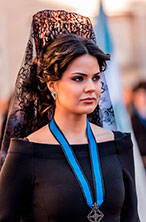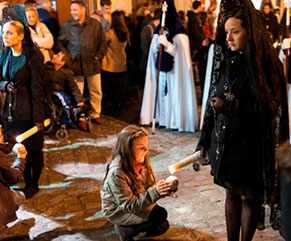Seville has many events, but one of the biggest and most important religious festivals is the ‘Semana Santa’. This holy week starts 25 March and ends 1 April. This is an amazing time to visit Seville. The first time Semana Santa was held was in 1350, and eversince then people from all over the world have traveled to Seville every year to see the impressive processions and lifelike statues on the streets of this historic city.
The traffic in the centre is shut down, to ensure people can see and reach everything on foot without getting disturbed by the traffic. This means that the city will be absolutely full of people everywhere. Every little street will be occupied by a lot of people wanting to catch a glimpse of the beautiful processions passing through the streets. So, if you want to go shopping or see the sights, I would recommend you to do this in the morning, so you can reach different places easily without having to wait in queues.
During the afternoon, you will be able to enjoy the smell of burning candles, peaceful music and processions. Sixty brotherhoods of Seville are holding lifelike Christian sculptures, people are wearing pointy-hoods, individual scenes take place, a cappella choirs and quartets sing along and brass bands float through Seville. Every brotherhood presents a different bible scene. A procession consists of several  ‘paseos’. These are a set of images which you will see on top of the moveable floats. Some of the oldest sculptures were made in the 16th century, and every year new ones are added. All of them are all richly decorated with flowers, wonderful fabric and candles. The ones dedicated to Jesus consist of figures of wood, wax, and wire to explain scenes from the Passion, and are usually concealed in gold. The paseos devoted to the Virgin Mary are usually covered in silver, and show Mary grieving her Son’s death and sometimes she is holding Him in her arms. The pointy-hoods of the penitents do not refer with the Ku Klux Klan, but were made this way so the faithful could do penance in anonymity.
‘paseos’. These are a set of images which you will see on top of the moveable floats. Some of the oldest sculptures were made in the 16th century, and every year new ones are added. All of them are all richly decorated with flowers, wonderful fabric and candles. The ones dedicated to Jesus consist of figures of wood, wax, and wire to explain scenes from the Passion, and are usually concealed in gold. The paseos devoted to the Virgin Mary are usually covered in silver, and show Mary grieving her Son’s death and sometimes she is holding Him in her arms. The pointy-hoods of the penitents do not refer with the Ku Klux Klan, but were made this way so the faithful could do penance in anonymity.
They start walking from their own religious communities to the cathedral and then they gather together at the city hall, near Plaza Nueva. Afterwards they go back to their communities. It sometimes takes them about 14 hours to finish the procession.
They continue from Palm Sunday to Easter Sunday morning. The peak of the week is the night of Holy Thursday, when the parades set out to arrive at the Cathedral on the dawn of Good Friday, known as the ‘madrugá’.

Woman wear ‘La Mantilla’. These are traditional suites worn by females on Thursday and Good Friday. These were first worn in the 1980’s. They consist of a lace mantle with shells or other materials and a black dress (usually just over the knees), with black shoes. These women wear beautiful jewellery and hold also a rosary.
 The processions last several hours, so it is nice to have your own seat. Therefore we advise you to rent a balcony or a chair from the locals, so you can enjoy the processions at the fullest. The inhabitants have also decorated their balconies, which is lovely to watch. However, not everyone gets a seat, since there are not enough seats for the whole city. It's still possible to watch the processions, even though you didn't manage to get a seat or a balcony. You can download the app Cruz de Guía, or find some booklets they have in various shops to see the maps and routes of the different processions, and try to find a spot in the streets where a procession is going to pass. You'll have to be patient, but when you aquire a spot and see the procession pass by up close, it will be an expierence of a lifetime, one you'll never forget!
The processions last several hours, so it is nice to have your own seat. Therefore we advise you to rent a balcony or a chair from the locals, so you can enjoy the processions at the fullest. The inhabitants have also decorated their balconies, which is lovely to watch. However, not everyone gets a seat, since there are not enough seats for the whole city. It's still possible to watch the processions, even though you didn't manage to get a seat or a balcony. You can download the app Cruz de Guía, or find some booklets they have in various shops to see the maps and routes of the different processions, and try to find a spot in the streets where a procession is going to pass. You'll have to be patient, but when you aquire a spot and see the procession pass by up close, it will be an expierence of a lifetime, one you'll never forget!
This is really an must-visit event, because you’ll probably never attend something like this again! It is likely that you have never seen so many lifelike images before. If you just can’t get enough of this, you will also be glad to be in Seville when it is Fería de Abril (April Fair), which takes place two weeks later.